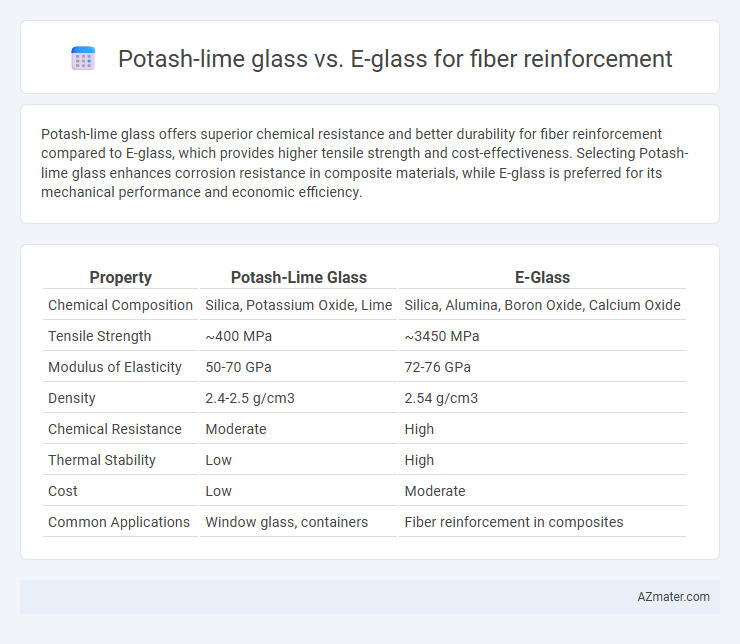Potash-lime glass offers superior chemical resistance and better durability for fiber reinforcement compared to E-glass, which provides higher tensile strength and cost-effectiveness. Selecting Potash-lime glass enhances corrosion resistance in composite materials, while E-glass is preferred for its mechanical performance and economic efficiency.
Table of Comparison
| Property | Potash-Lime Glass | E-Glass |
|---|---|---|
| Chemical Composition | Silica, Potassium Oxide, Lime | Silica, Alumina, Boron Oxide, Calcium Oxide |
| Tensile Strength | ~400 MPa | ~3450 MPa |
| Modulus of Elasticity | 50-70 GPa | 72-76 GPa |
| Density | 2.4-2.5 g/cm3 | 2.54 g/cm3 |
| Chemical Resistance | Moderate | High |
| Thermal Stability | Low | High |
| Cost | Low | Moderate |
| Common Applications | Window glass, containers | Fiber reinforcement in composites |
Overview of Potash-Lime Glass and E-Glass
Potash-lime glass consists primarily of potassium oxide and lime, offering moderate chemical durability and thermal stability, commonly used in applications requiring cost-effective reinforcement. E-glass, or electrical-grade glass, contains alumina and boron oxides, providing superior tensile strength, electrical insulation, and resistance to heat and moisture, making it the preferred fiber reinforcement in composites. The distinct composition of E-glass results in enhanced mechanical properties and durability compared to potash-lime glass, influencing its widespread adoption in advanced fiber-reinforced materials.
Chemical Composition Comparison
Potash-lime glass typically contains higher amounts of potassium oxide (K2O) and lime (CaO), resulting in improved chemical durability compared to E-glass, which is predominantly composed of silica (SiO2), alumina (Al2O3), and boron oxide (B2O3) aimed at enhancing electrical resistivity and mechanical strength. E-glass features a composition with approximately 52-56% SiO2, 12-16% Al2O3, and 16-25% CaO, whereas potash-lime glass contains about 50-60% SiO2, 10-15% K2O, and 5-10% CaO. The differences in chemical composition between potash-lime and E-glass influence fiber reinforcement performance, chemical resistance, and compatibility with various matrix materials in composite applications.
Mechanical Properties: Strength and Durability
Potash-lime glass exhibits lower tensile strength and fracture toughness compared to E-glass, leading to reduced overall mechanical performance in fiber reinforcement applications. E-glass fibers demonstrate superior durability with enhanced resistance to moisture and chemical degradation, contributing to longer lifespan and consistent structural integrity. The higher tensile modulus of E-glass makes it preferable for high-strength composites requiring improved load-bearing capacity and durability in harsh environments.
Thermal Stability and Performance
Potash-lime glass exhibits lower thermal stability compared to E-glass, limiting its performance in high-temperature fiber reinforcement applications. E-glass maintains structural integrity at temperatures up to 540degC, making it ideal for composites exposed to thermal stress. Enhanced thermal resistance in E-glass translates to superior durability and mechanical properties under elevated temperature conditions.
Moisture and Chemical Resistance
Potash-lime glass fibers exhibit lower chemical and moisture resistance compared to E-glass fibers, making E-glass more suitable for fiber reinforcement in harsh environmental conditions. E-glass demonstrates superior durability and stability when exposed to water and various chemicals due to its optimized silica and alumina composition. This enhanced resistance leads to longer service life and reduced degradation in composite materials reinforced with E-glass fibers.
Fiber Manufacturing Processes
Potash-lime glass and E-glass differ significantly in fiber manufacturing processes, with E-glass favored for its superior chemical durability and mechanical properties essential for high-performance fiber reinforcement. E-glass fibers are produced through controlled melting and rapid drawing techniques, ensuring uniform diameter and minimizing defects, while potash-lime glass fibers require lower melting temperatures but exhibit less consistency and strength. Manufacturing E-glass fibers involves precise raw material formulations and advanced filament winding or roving processes, optimizing their use in composite materials for automotive, aerospace, and construction industries.
Applications in Fiber Reinforcement
Potash-lime glass is primarily used in applications requiring moderate strength and lower cost, such as in insulation and general-purpose fibers for composite materials. E-glass, with superior tensile strength and chemical resistance, is extensively employed in high-performance fiber reinforcement for aerospace, automotive, and marine composites. E-glass's enhanced durability and fiber-matrix adhesion make it the preferred choice for structural applications demanding long-term reliability and mechanical performance.
Cost and Commercial Availability
Potash-lime glass is significantly cheaper than E-glass, making it a cost-effective option for fiber reinforcement in applications where budget constraints are critical. E-glass dominates commercial availability, widely produced and accepted in industries such as aerospace and automotive due to its superior mechanical properties and chemical resistance. While potash-lime glass fibers are less prevalent in the market, they offer a niche alternative for non-structural composites requiring basic reinforcement at lower costs.
Environmental Impact and Sustainability
Potash-lime glass fibers generally have a lower environmental impact compared to E-glass due to their simpler composition and lower energy-intensive manufacturing process, resulting in reduced carbon emissions. E-glass, while offering superior mechanical properties and durability for fiber reinforcement, requires higher raw material inputs and energy consumption, which contribute to greater ecological footprint and waste generation. Selecting potash-lime glass over E-glass can enhance sustainability in composite applications by minimizing resource depletion and supporting more eco-friendly production cycles.
Selection Criteria for Engineering Use
Potash-lime glass offers superior chemical resistance and thermal stability, making it suitable for environments with high moisture or alkaline exposure, while E-glass provides higher tensile strength and electrical insulation properties preferred in structural and electrical applications. Selection criteria for engineering use prioritize mechanical strength, environmental durability, and cost-effectiveness, with E-glass favored for load-bearing composites due to its optimum strength-to-weight ratio. Potash-lime glass is chosen when enhanced chemical durability is critical, despite lower mechanical performance compared to E-glass in fiber reinforcement applications.

Infographic: Potash-lime glass vs E-glass for Fiber reinforcement
 azmater.com
azmater.com